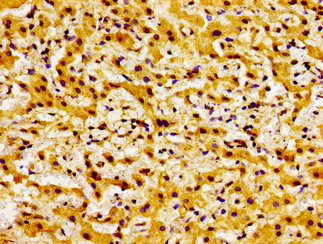
Immunohistochemistry of paraffin-embedded human liver cancer using CSB-PA892353LA01HU at dilution of 1:100
BOK Antibody

CSB-PA892353LA01HU
ApplicationsELISA, ImmunoHistoChemistry
Product group Antibodies
ReactivityHuman
TargetBOK
Overview
- SupplierCusabio
- Product NameBOK Antibody
- Delivery Days Customer20
- ApplicationsELISA, ImmunoHistoChemistry
- CertificationResearch Use Only
- ClonalityPolyclonal
- ConjugateUnconjugated
- Gene ID666
- Target nameBOK
- Target descriptionBCL2 family apoptosis regulator BOK
- Target synonymsBCL2 related ovarian killer; BCL2L9; bcl2-L-9; bcl-2-like protein 9; bcl-2-related ovarian killer protein; BOK, BCL2 family apoptosis regulator; BOKL; hBOK
- HostRabbit
- IsotypeIgG
- Protein IDQ9UMX3
- Protein NameBcl-2-related ovarian killer protein
- Scientific DescriptionIsoform 1: Apoptosis regulator that functions through different apoptotic signaling pathways (PubMed:27076518, PubMed:15102863, PubMed:20673843). Plays a roles as pro-apoptotic protein that positively regulates intrinsic apoptotic process in a BAX- and BAK1-dependent manner or in a BAX- and BAK1-independent manner (PubMed:27076518, PubMed:15102863). In response to endoplasmic reticulum stress promotes mitochondrial apoptosis through downstream BAX/BAK1 activation and positive regulation of PERK-mediated unfolded protein response (By similarity). Activates apoptosis independently of heterodimerization with survival-promoting BCL2 and BCL2L1 through induction of mitochondrial outer membrane permeabilization, in a BAX- and BAK1-independent manner, in response to inhibition of ERAD-proteasome degradation system, resulting in cytochrome c release (PubMed:27076518). In response to DNA damage, mediates intrinsic apoptotic process in a TP53-dependent manner (PubMed:15102863). Plays a role in granulosa cell apoptosis by CASP3 activation (PubMed:20673843). Plays a roles as anti-apoptotic protein during neuronal apototic process, by negatively regulating poly ADP-ribose polymerase-dependent cell death through regulation of neuronal calcium homeostasis and mitochondrial bioenergetics in response to NMDA excitation (By similarity). In addition to its role in apoptosis, may regulate trophoblast cell proliferation during the early stages of placental development, by acting on G1/S transition through regulation of CCNE1 expression (PubMed:19942931). May also play a role as an inducer of autophagy by disrupting interaction between MCL1 and BECN1 (PubMed:24113155).
- ReactivityHuman
- Storage Instruction-20°C or -80°C
- UNSPSC12352203
